Do you love dogs? Are you crazy about cats?
Or are you part of a special group that can’t get enough of both?
‘The more the merrier’ is a turn of phrase heard by many pet parents…
But if you do have more than one pet, or you’re thinking of adding to the family, how do you keep the peace?
Multi-pet households of dogs and other pets, such as cats and small animals, can be a handful if not everyone is getting on.
That’s why we’ve put together this post for you, to give some useful tips on advice on keeping your furry family happy.
So you can enjoy spending time with all your pets, and they can enjoy each other’s company without chaos.
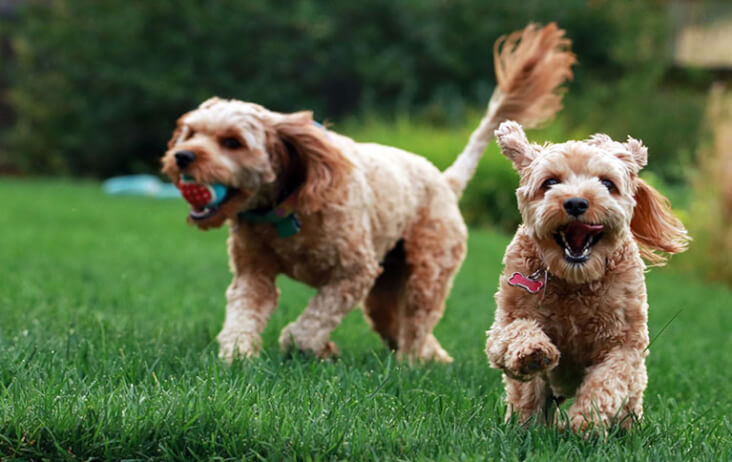
Introducing A New Dog Or Puppy To Your Home
Step 1: Choosing the right dog.
Getting a new canine member of the family is exciting. But if you already have a dog (or dogs) at home, there are a few things you might need to do to make it easier on them.
Dogs are naturally sociable animals who enjoy each other’s company and most will thrive having a companion to live with.
But, first you should think about your dog’s personality.
- Does your dog get on well with other dogs?
- Are they ever aggressive towards other dogs?
- Do they demand attention and get jealous of sharing your affection?
If you answered yes to any of the above questions, it is a good idea to think about your current dog’s happiness before committing to another.
If your dog is picky about the dogs they get on well with, it might be best to adopt an adult dog from a rehoming centre. This way you can choose a dog with a personality that complements theirs. As a puppy is usually much more of a wildcard.
If your dog is submissive and calm, they could probably learn to share the home with any dog. This means a puppy could still be an option. But if your dog has a dominant personality, it will be best to adopt a dog who is more laid back and won’t cause any friction.
And if you do adopt a puppy, bear in mind that they will still have a lot to learn in regards to getting along with others. Your adult dog will often have to teach them social rules and etiquette.
The most important thing to bear in mind is your current dog’s wellbeing. If you don’t think they would enjoy sharing the home with another dog, keep their best interests in mind. But if you think they would love a playmate, another dog can bring even more happiness to your home.
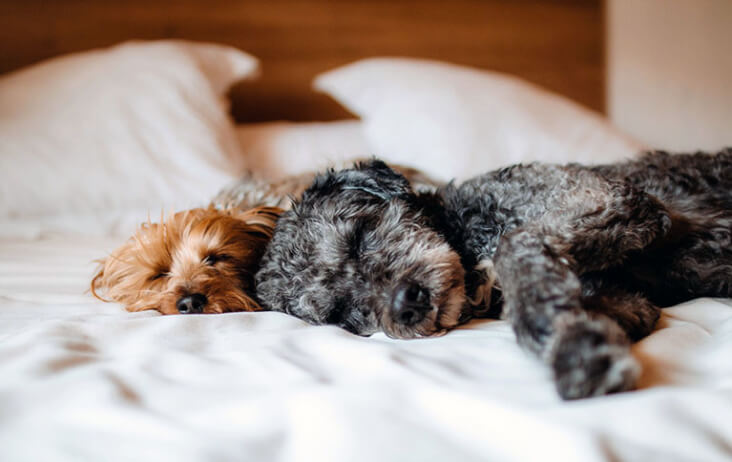
Step 2: Introducing your current dog to the new family member.
If you’ve decided to adopt a new canine family member you might be wondering how to introduce them to your current dog. That is, without causing any problems. Don’t worry, we’ve got you covered with some helpful tips…
Start by introducing the dogs in neutral territory. This could be a neighbour or friend’s garden, or a park. The key is to make sure neither of the dogs have been there before.
If you’re adopting a puppy and aren’t sure how your dog will react, it might be best to socialise the puppy with other dogs first. This should be done with dogs who deal well with puppies and can teach them some boundaries (without getting aggressive). A young puppy with no manners can get on the nerves of even the most tolerant of dogs.
Get another family member or a friend to help you introduce the two dogs. Each dog should be on a separate lead and be handled separately.
Start by simply walking the two dogs around in the vicinity of each other. Use positive reinforcement at all times and make sure you offer plenty of tasty treats. Reward all good behaviour – even just being around each other is a big achievement at this stage.
If the two dogs seem to be calm around each other, let them say hello to each other. This will usually take the form of sniffing from behind. Don’t force them to interact face to face against their will, as this can be scary for both dogs.
Once the dogs seem to be getting along well on the lead, you can let them off. This interaction must be supervised heavily in case you have to step in. If either dog shows aggression, go back several steps and continue positive reinforcement.
Don’t discourage natural reactions, such as growling or grumbling, unless one of the dogs becomes aggressive. These reactions might be prevalent where a puppy is being introduced to an adult dog. An adult dog will often be teaching the puppy useful lessons about boundaries and manners.
And if you need a helping hand understanding your dog’s communication signals, check out our blog post with some handy tips here.
Once the dogs are tolerating each other well, you can bring both of them home.
Before you let your new dog into the house, make sure to move any well-loved toys or items such as blankets and bones. This will help avoid resource guarding.
For the first few weeks, it is also important to feed your dogs separately. This is because dogs will often become protective over their food. If they think another dog is trying to take it off them it might lead to aggression and fighting.

What If My Dogs Don’t Get Along?
It can be distressing if you have two (or more) dogs in the home that just don’t get along. Fights, barking and aggression are not nice.
Often, these problems are a result of a poor introduction or a mismatch of personalities. That’s why it is so important to carefully consider whether getting a new dog is a good idea, and to make sure you take your time with introductions.
It is not always a good idea to try and sort out any behavioural issues between your dogs alone. Contact a recommended behaviourist who can assess your dogs and provide them with training.
Take steps to eliminate any grounds for conflict by:
- Making sure you feed your dogs separately to avoid fights over food
- Giving each dog their own space and bed so they can have alone time when they want it
- Not encouraging sharing of well-loved toys, bones and treats to avoid resource guarding
- Giving your dog one to one attention at times
Keep in mind that if your dogs really can’t get on, the only option may be to rehome one of them.
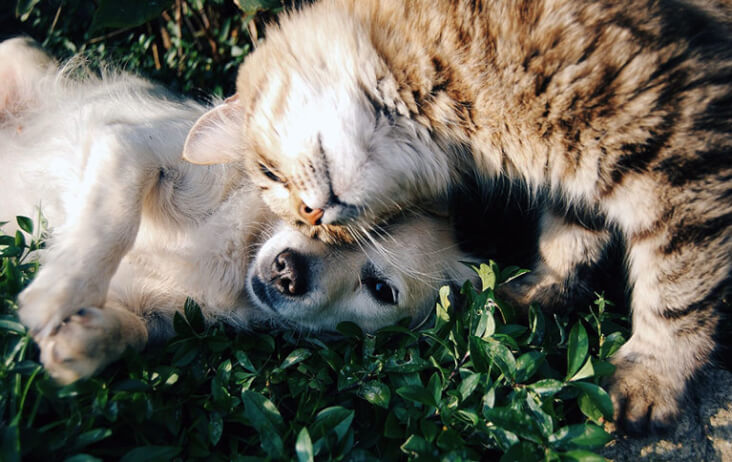
How To Help Dogs and Cats Get Along
Dogs and cats are often portrayed as sworn enemies. But the good news is that they can get along.
Proper introductions between cats and dogs are crucial. If you have a cat and dog living together keep in mind that they don’t have to interact, but should be taught to tolerate and respect each other.
If you’re just about to introduce the two, scent swapping can make a great start on things going smoothly. Take two pieces of cloth, and rub one gently across each animal’s scent glands. These are a cat’s head and chin, and a dog’s paws and underarms. Then swap them, and give them to your pets to smell. They will begin to get used to the other’s scent and learn about each other before they’ve even met.
If you are bringing a new dog or puppy into the house, make sure the cat has plenty of high spaces to escape to. Also give the cat a room to itself that the dog cannot access.
Start by introducing the dog and cat from two sides of a barrier, such as a baby gate or a glass door. If your dog is crate trained, this is also an option. Repeat this interaction several times until the pets start to become more at ease around each other.
Once the pets are used to seeing and smelling each other, you can try introducing them in the same room. Keep your dog on their lead for the first few interactions like this. Reward them with treats or tasty food for staying calm.
Give your cat the option to approach the dog, not the other way around. And don’t force your cat to stay in the room – if their natural instinct is to run away, let them.
The cat might also hiss at, growl at, or hit the dog. As long as your dog is not at risk of harm, let these interactions take place – it will teach the dog to leave the cat alone.
It is also important not to let the dog chase the cat. While the dog might only be playing, the cat doesn’t know this and might become scared to be around the dog.
Eventually, your cat and dog should start getting along, or at least tolerating each other. Until this point, don’t leave them unattended together.
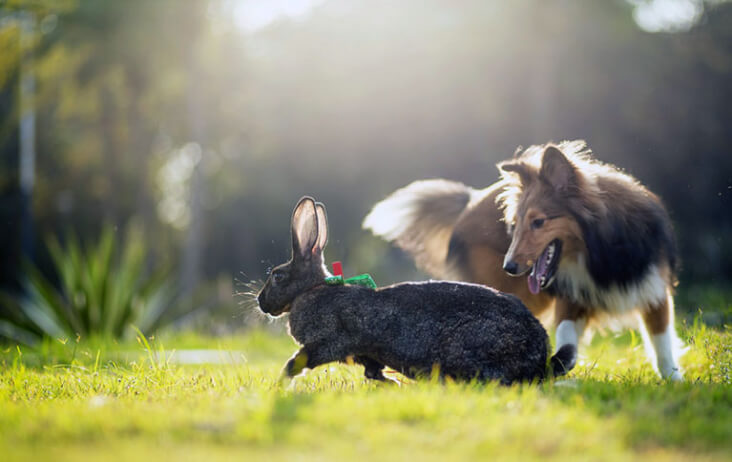
Can Dogs And Small Animals Get Along?
Rabbits, guinea pigs, hamsters… small ‘pocket pets’ are popular in the UK.
The truth is, dogs don’t see these small pets as part of the pack. Dogs have prey instincts and unfortunately this doesn’t distinguish between wild animals and pets.
Do not attempt to introduce your dog to your small pet. Instead teach them that it is more rewarding to leave the animal alone. Use positive reinforcement training with your dog’s favourite treats to teach them that being calm and ignoring the small pet pays off. Eventually, your dog will learn that the best thing to do is stay away.
Cages and hutches should be securely locked when you aren’t around and preferably should be kept in an area where you dog won’t be able to access them unsupervised.
If you own a dog bred to chase and hunt prey it might be best not to adopt any small animals into the family. Breeds such as greyhounds will have a natural instinct to chase and kill any small animal, perfected through years of training. This is not an ideal instinct to combine with a family pet rabbit or guinea pig.
Final thoughts…
Having multiple pets in the family is fantastic fun. But problems can happen. By taking steps to check if any new pet will be compatible and introducing them correctly you will be well on your way.
Proper introductions to each new animal is the most important thing to get right. If this doesn’t happen it is more likely that you will have problems as time goes on.
With the right training, dogs can quickly learn to get along with other dogs and cats. And if you teach them well, they can also learn to live in the same space as smaller pets.
As long as you keep your dog’s best interests in mind, you can keep the peace in your household and enjoy spending time with all of your pets. And they can enjoy spending time together too.
References
www.bluecross.org.uk
www.akc.org
www.pdsa.org.uk
www.cats.org.uk
Youtube: Zak George’s Dog Training Revolution
Connie Swaim and Deb Elredge, ‘Idiot’s Guides: Puppies’, Penguin 2014.

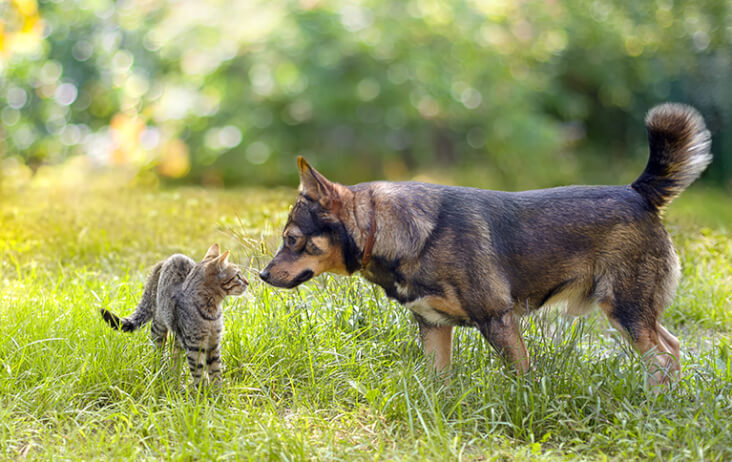




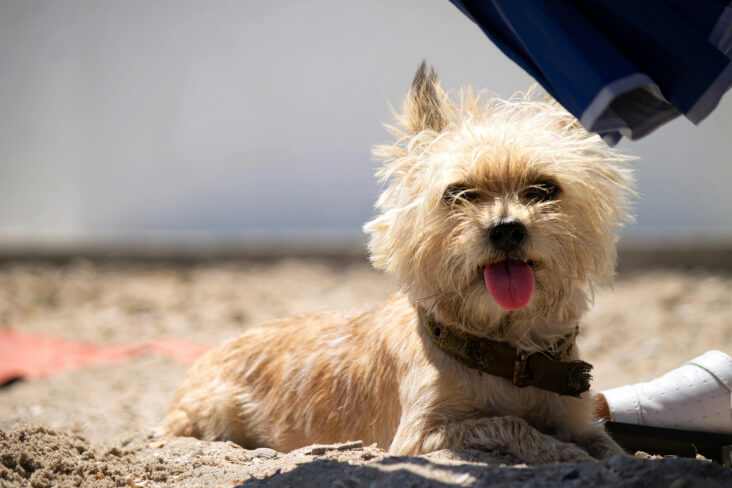
Comments